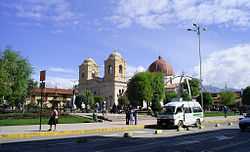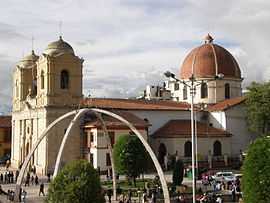Huancayo
| Huancayo | |||
|---|---|---|---|
| Santísima Trinidad de Huancayo Holy Trinity of Huancayo | |||
 | |||
| |||
|
Nickname(s): "La Ciudad Incontrastable" (The Uncontrastable City) | |||
 Huancayo | |||
| Coordinates: 12°4′S 75°13′W / 12.067°S 75.217°WCoordinates: 12°4′S 75°13′W / 12.067°S 75.217°W | |||
| Country | Peru | ||
| Region | Junin | ||
| Province | Huancayo | ||
| District | Huancayo | ||
| Founded | 1 June 1572 | ||
| Government | |||
| • Type | Municipal government | ||
| • Mayor | Dimas Aliaga Castro | ||
| Elevation | 3,259 m (10,692.26 ft) | ||
| Population | |||
| • Total | 380,000 | ||
| Time zone | PET (UTC-5) | ||
| • Summer (DST) | PET (UTC-5) | ||
| Area code(s) | 64 | ||
| Website | www.munihuancayo.gob.pe | ||



Huancayo (Spanish pronunciation: [waŋˈkaʝo]; in Wanka Quechua: Wankayuq [wɐŋˈkæjuː], '(place) with a (sacred) rock') is the capital of the Junín Region, in the central highlands of Peru.
Location
It is located in Huancayo Province, of which it is also capital. Situated in the Mantaro Valley at an altitude of 3,271 meters, it belongs to the Quechua region. Depending on delimitation, the agglomeration has a population between 340,000 and 380,000[1] and is the fifth most populous city of the country. Huancayo is the cultural and commercial center of the whole central Peruvian Andes area.
Historical overview
Pre-columbian era
The area was originally inhabited by the Huancas. At around 500 BC, they were incorporated into the Wari Empire. Despite efforts to defend its independence, the Huancas were eventually subdued by the Inca leader Pachacutec in 1460 and the region was incorporated into the Inca empire. It subsequently became a notable stopping point along the Inca Camino Real.
Viceroyalty era
After the Spanish colonization (1534), Huancayo was overshadowed by Jauja, 18 km to the north, which the conquistador Francisco Pizarro established as a provisional capital of Peru until Lima took over that role. In 1570, the viceroy Francisco de Toledo established the site as the center of his encomienda Guancayo. The town was officially established on 1 June 1572 with the title of Santísima Trinidad de Huancayo. In 1813, Huancayo celebrated the promulgation of the Constitution of Cadiz, changing the name of the "Plaza del Comercio" to "Plaza de la Constitución".
Republican era
During the war for independence, Huancayo was liberated on 20 November 1820. Construction on the cathedral commenced in 1831. In 1854, when Peru officially ended slavery, the accord was made law in Huancayo. There is a statue in the Plaza Constitución commemorating this.
Recent situation
In 1969, two earthquakes struck Huancayo, destroying hundreds of homes, damaging in bridges, railways and killing 800-1,000 people. Landslides killed an additional 300 people in suburban districts and near the Huaytapallana mountain. Today, in addition to its importance as a center of commerce, Huancayo is known for the crafts and the many festivals of the surrounding towns. Having rapidly expanded in recent decades, it has few remaining colonial buildings; the cityscape is dominated by modern constructions.
Demographics
According to the national Census of 2007,[2] the three main districts of Huancayo have a total population of about 340,000. However, the continuous settlement area already reaches periurban districts. Hence, the agglomeration's population reaches at least 380,000 people. Amerindian and Mestizos (Amerindian and Spanish ancestry) are the two largest ethnic groups in the city. Asian (mainly descendants of Japanese and Chinese immigrants) and European descendants are important minority groups.
| Municipalities of the city |
Area km² |
Population censo 2007(hab) |
Population under 1 year-old Censo 2007(hab) |
Households (2007) |
Density (hab/km²) |
Elevation msnm | |
|---|---|---|---|---|---|---|---|
| Chilca | 8,3 km² | 77.392* | 1.358* | 17.509 | 9.324,33 | 3.275 msnm | |
| El Tambo | 73,56 km² | 146.847* | 2.365* | 36.982 | 1.996,28 | 3.260 msnm | |
| Huancayo | 237,55 km² | 112.054* | 1,789* | 27.552 | 471,70 | 3.249 msnm | |
| Total | 319,41 km² | 336.293* | 5.512* | 82.043 | 1.052,85 | — | |
| *Data from the census taken by the INEI[3] | |||||||
Transport
The agglomeration Huancayo counts with transportation connections by air, road and rail. First, the Francisco Carle Airport at Jauja offers daily connections to Lima. Second, the Carretera Central links Huancayo with La Oroya and Lima. Third, the Ferrocarril Central Andino enables transport by rail. Huancayo was a break-of-gauge from 914 mm (3 ft) gauge to 1,435 mm (4 ft 8 1⁄2 in) gauge; for the 147 km extension to Huancavelica. In 2009, this line was being standardised.[4] A light rail is currently under construction and expected to start operation in 2013.
Education
Local universities
- Universidad Nacional del Centro del Peru (UNCP)
- Universidad Peruana Los Andes (UPLA)
- Universidad Continental de Ciencias e Ingenieria (UCCI)
- Universidad Franklin Roosevelt (UFR)
Branches of other Peruvian Universities
- Universidad Alas Peruanas (UAP)
- Universidad Los Angeles de Chimbote (ULADECH)
- Universidad Nacional Mayor de San Marcos (UNMSM)
- Universidad Nacional Daniel Alcides Carrión (UNDAC)
- Universidad de Huanuco (UDH)
Language Institutes
- Instituto Cultural Peruano Británico (BRITANNIA)
- Instituto Cultural Peruano Norteamericano - Región Centro (ICPNA)
- Alianza Francesa de Huancayo (French Alliance, AF)
Notable people
- Damaris Mallma Porras (1986- ), Peruvian folk singer
- Josué Sánchez (1945- ), painter
- Rodolfo Cerrón Palomino (1940- ), linguist
- Víctor Alberto Gil Mallma (1930–1975), musician
- Juan Parra del Riego (1894–1925), poet
See also
- Wankas
- Plaza El Coliseo, bull-fighting stadium
References
- ↑ "Huancayo Statistics, Information, Weather", TravelsRadiate, 3 Aug 2011, accessed 3 Aug 2011.
- ↑ Instituto Nacional de Estadística e Informática, Perfil Sociodemográfico del Perú pp. 29–30, 32, 34.
- ↑ Censo 2005 INEI
- ↑ Trains, March 2009, p68
External links
- (Spanish) Official Municipal website
- (Spanish) Archdiocese of Huancayo
- (Spanish) Community of Huancayo
- (Spanish) Tourist information of Huancayo
- Radio Antena Sur, Huancayo

